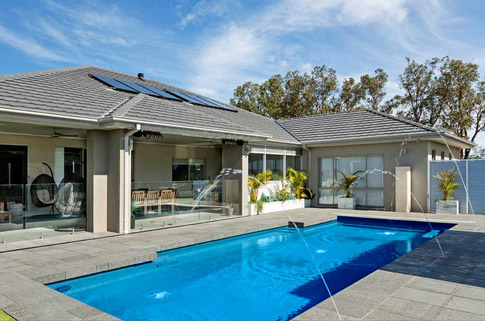Things to Consider While Designing Lap Pool

The purpose of having a kind of swimming pool that is called lap pool, is to have better health and fitness. Usually such lap pools are narrow in width however its length are at least 45 feet or more. These types of pools rectangular in shape is ideal for such residences where there are narrow or shallow space available and the homeowners like to build pool in order to do exercise in the privacy of his own backyard.
If it is viewed from the house then the pool looks to be the focal point of the whole yard. Since nowadays there are space constraints in most of the residential plots, lap pools are gaining its foothold.
Origination of lap pools
The concept of swimming pools is not very new but it existed during ancient roman and Greek period too. They used to build such rectangular pool for doing various kinds of athletic training in their gymnasium, for doing military exercises, for nautical games etc. Private pools of Roman emperors were full of fishes and it was called piscinas.
Equipment
If you are looking to do workouts as well as laps in your pool then you should get some pool exercise equipment from My Pool My Gym this will help to vary your workouts and increase intensity whilst removing next day soreness and remaining injury free.
What you need to consider for lap pool?
Following are few things that you need to consider while implementing the project of lap pool according. According to the CEO of Compass Pools Melbourne who are one of the top Australian pool builders, fibreglass pools make a better choice when compared to the concrete pools.
Pool dimension -
As far as the length of the pool is concerned, there is no limitation. However, depending upon the space available in your backyard, one should be able to do good swim without making too many turns. Usual lengths chosen for such pools are 12.5 m, 15 m, 20m and 25 m depending upon the available space.
Advantage of any concrete pool is that you can make pool of any desired sizes that you want. Width of such pools are usually 2.5 m so that at least two people can swim side by side. At some places if there is enough space then 4m width pools can also be constructed. Depth of the pool should be around 2m. in some places depth of 1.2m can also be done. However, the construction and maintenance of concrete pools is expensive.
On the other hand, fibreglass pools offer a much affordable option, as they can be customized as per the space availability. New technology allows for fusing or joining of multiple fibreglass pool shells together, for creating pools of custom lengths. The technology can be used to create swimming pools of up to 30 meters. Installation of these pools is much cheaper and faster, when compared to the concrete ones.
Heating -
If you are planning to swim during summer days then solar heating is good enough however if you want to swim during morning or evening or during winter seasons then some alternate arrangement for heating will be needed. Typically, people prefer to use gas heating for such pools.
Pool cover -
Some people prefer to build such pool indoor so that it is not exposed to outdoor atmosphere. This can also help in conserving energy for heating the pool. However, if you prefer the pool to be outdoor then you can have polycarbonate domes to cover the pool. This can help in providing little thermal blanket for your pool.
Utility -
Such pool can serve very well for your family to meet their exercising needs and instead of visiting to any spa or swim out you can use your lap pool for maintaining better health.
Access - You may either have internal steps to enter into swimming or offset steps with stainless steel material for grab rail.

